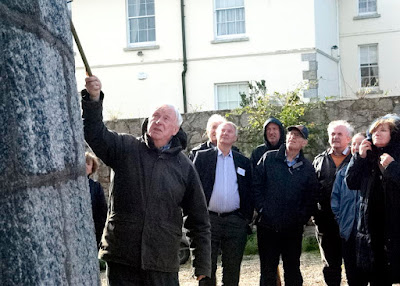Tuesday, October 02, 2018
BY THE SWORD
For a brief moment I thought the French had finally decided to attack and here they were coming over the wall onto the battery plain of Martello Tower No.7 which had been specifically built to ward them off.
When the moment had passed I realised that it was the group from the Military History Society of Ireland (MHSI) who had quietly invaded the site while Niall and I were inside the gunner's cottage sipping tea.
The fear of the French was real, but many moons ago. The towers were built in a hurry to deter them, or deal with them if they ever came. Mind you, they had come some years earlier to limited success in the West. They briefly occupied Mayo, set up an Irish Republic, and routed the British at Castlebar. But then it all fell apart and the British slaughtered the Irish, including prisoners of war, and it was all over. But we have not forgotten and, were it not for the damage it will inflict on us, we would be having a severe bout of schadenfreude at their current brexit shambles.
But back to the French who were expected back, and so the Towers were built. But the French never did come back and the towers were never to see any action. Nevertheless this tower has what I think must be the unique distinction of having fired on a French frigate.
My connection with the MHSI goes back to 1975 when they published my essay on La Chaussée's report in the Irish Sword. Then my cousin met a man at a MHSI meeting who later provided information on my uncle's death in WWI. And finally I have attended some of their talks in Wellington Barracks (now Griffith College) in recent times.
And, as it turned out at the tower, I knew some of the visitors from other encounters but had never associated them with the MHSI. Life is full of surprises.
When they arrived at the tower the group were in the middle of a very busy day. Their programme on The Defences of Dublin - 18th and 19th Century included the Magazine Fort in the Phoenix Park, the Pigeon House, Dun Laoghaire Pier, and the Martello Tower.
Harman Murtagh had been my editor for the Sword essay in 1975. He also turned out to be a friend of Niall's from Athlone, whom he hadn't seen in fifty years. I had come across Pat at recent MHSI meetings in Wellington Barracks (now Griffith College) and at the launch of his book The Redmonds and Waterford in the RIA.
Niall is patiently and authoritatively explaining the restoration of the tower and also some of the fascinating engineering aspects of the original.
Pat is quietly subjecting all this to critical analysis, as any good historian must.
Niall tells the story of the multiple doors and points out the insignificant pelmet over one of the openings.
No question but the audience is hanging on his every word.
Then there is the glacis (steep bank) and the 230 x 20 ton truckloads of rubbish which had to be removed from the site, including from where the group are now standing.
Then there was the detective work involved in figuring out how the artillery room's slated roof could be supported without resorting to internal pillars. And the heritage conundrum where windows which had replaced the original musket loops were now impeding the latter's restoration as the later windows had acquired their own heritage status along the way.
Then it was in to the artillery room to see a video of the casting of the cannon.
Niall proudly displayed his Gunner's Certificate which entitled him to fire the cannon.
Following an arduous climb up the narrow spiral staircase the group emerged onto the crown of the tower.
One member of the group looked anxious to go straight into battle.
But first you have to point the canon in the general direction of the enemy.
And then adjust the rather crude mechanism to get the elevation for the range.
At the time of its construction this tower could command a view of the other eight defensive positions (towers and batteries) in the bay. This is no longer the case as some have disappeared and others are obscured by the more recent trees.
No, that building you see next door is not Bono's house. It is the "curse of NAMA" which has been known to emit toxic fumes. Mind you, Bono's house and those of The Edge and of Enya are in easy range of the cannon.
On behalf of the group, Kenneth Ferguson presented Niall with copies of the Irish Sword which contained articles relevant to the tower. I noticed that the red one is from 1975 and contains my La Chaussée essay.
You can follow up on the tower at this dedicated website, and this article will give you some background to the items covered during the group's visit.
Subscribe to:
Post Comments (Atom)


















No comments:
Post a Comment
Bona fide comments only. Spamming, Trolling, or commercial advertising will not be accepted.